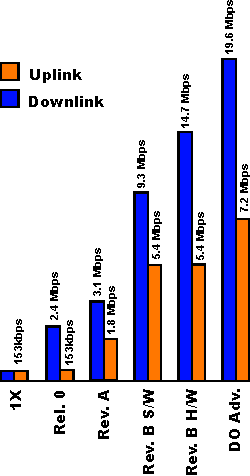CDMA2000 1xEV-DO Basics
- basics of CDMA2000 1xEV-DO - EV-DO or EVDO for data only or data optimised cellular telecommunications standard as defined in IS-856 (TIA-856).
cdmaOne / cdma2000 Technology Includes:
IS95 / cdmaOne
IS95 radio access interface
IS95 handoff / handover
IS95 data channels
cdma2000 1X
cdma2000 1X data channels
cdma2000 1X Advanced
cdma2000 1X EV-DO
1X EV-DO radio interface
1X EV-DO data channels
1X EV-DO Rev.B
1X EV-DO Advanced
UMB: 4G UltraMobile Broadband
CDMA2000 1xEV-DO cell phone system is a standard that has evolved from the CDMA2000 mobile phone system and it is now firmly established in many areas of the world. The letters EV-DO sometimes referred to as EVDO stand for Evolution Data Only or Data Optimised. From the 1xEV-DO title it can be seen that it is a data only mobile telecommunications standard that can be run on CDMA2000 networks.
The concept of CDMA2000 1xEV-DO is that is a packet data only carrier - voice can be carried either by using Voice over IP, VoIP, or by using a fall-back to a CDMA2000 1X carrier. The fall-back mode is the one that tends to be used more widely as most operators have a CDMA2000 1X system in place.
CDMA2000 1xEV-DO Basics
The CDMA2000 1x EV-DO cell phone system is defined under IS-856 (TIA-856) rather than IS-2000 (TIA-2000) that defines the other CDMA2000 standards.
The EV-DO, IS-856 standard has undergone several revisions since it was first launched:
- EV-DO Release 0 (Rel. 0): This was the first release of the EV-DO standard.
- EV-DO Revision A (Rev. A): This revision of the standard introduced a significant increase in data rates.
- EV-DO Revision B (Rev. B): The EV-DO Rev. B version of the standard introduced a number of updates including multicarrier operation as a software upgrade and higher order modulation with the introduction of new hardware. These two upgrades can be undertaken separately.
- EV-DO Advanced: This software only upgrade introduced a number of smart features into the EV-DO standard.
- EV-DO Revision C (Rev.C): This is the Ultra-Mobile Broadband standard. This is not now being pursued as the evolution from EV-DO is now to LTE for 4G services.
It can be seen that the data rates have risen considerable with successive releases and revisions of the EV-DO standard.

The CDMA2000 1xEV-DO forward channel forms a dedicated variable-rate, packet data channel with signalling and control time multiplexed into it. The channel is itself time-divided and allocated to each user on a demand and opportunity driven basis. A data only format was adopted to enable the standard to be optimised for data applications. If voice is required then a dual mode phone using separate 1X channel for the voice call is needed. In fact the "phones" used for data only applications are referred to as Access Terminals or ATs.
EV-DO tabular summary
The table below gives an overview of the capabilities of the different releases and revisions of the CDMA2000 1x EV-DO standard.
| CDMA2000 1xEV-DO Release / Revision |
Max Downlink Data Rate (average throughput) |
Max Uplink Data Rate (average throughput) |
Comments |
|---|---|---|---|
| Rel. 0 | 2.4 Mbps (300-600 kbps) |
153.4 kbps (70-90 kbps) |
The first release of CDMA2000 1x EV-DO. 1.25 MHz FDD channels. |
| Rev. A | 3.1 Mbps (600-1400kbps) |
1.8 Mbps (500-800kbps) |
Backwards compatible with EV-DO Rel. 0. 1.25 MHz FDD channels. |
| Rev. B software |
9.3 Mbps | 5.4 Mbps | These figures are for operation in a 5 MHz FDD channel and for the EV-DO Rev. B software upgrade. The software upgrade provides the multi-carrier facility. Figures are for the software upgrade only. |
| DO Rev. B hardware |
14.7 Mbps | 5.4 Mbps | These figures are for operation in a 5 MHz FDD channel and for the EV-DO Rev. B hardware upgrade as well as the software upgrade. The hardware upgrade allows higher order modulation (up to 64QAM) to be used. |
| DO Advanced | 19.6 Mbps | 7.2 Mbps | Figures for 4 x 1.25 MHz FDD channels |
While many of the upgrades are implemented by software upgrades at the base station, new handsets, or Access Terminals, ATs are required to be able to utilise the features and data rates available. However ATs are normally replaced relatively frequently and as a result the new features are steadily taken up over time.
 Written by Ian Poole .
Written by Ian Poole .
Experienced electronics engineer and author.
Wireless & Wired Connectivity Topics:
Mobile Communications basics
2G GSM
3G UMTS
4G LTE
5G
Wi-Fi
Bluetooth
IEEE 802.15.4
DECT cordless phones
Networking fundamentals
What is the Cloud
Ethernet
Serial data
USB
LoRa
VoIP
SDN
NFV
SD-WAN
Return to Wireless & Wired Connectivity


